The NVIDIA GeForce GTX 780 Ti Review
by Ryan Smith on November 7, 2013 9:01 AM ESTPower, Temperature, & Noise
As always, last but not least is our look at power, temperature, and noise. Next to price and performance of course, these are some of the most important aspects of a GPU, due in large part to the impact of noise. All things considered, a loud card is undesirable unless there’s a sufficiently good reason – or sufficiently good performance – to ignore the noise.
| GeForce GTX 780 Series Voltages | ||||
| GTX 780 Ti Boost Voltage | GTX 780 Boost Voltage | GTX 780 Ti Base Voltage | ||
| 1.187v | 1.1625v | 1.012v | ||
Taking a quick look at voltages, we find that our GTX 780 Ti operates at a slightly higher voltage at its maximum boost bin than the original GTX 780 did. The difference is minor, but the additional voltage may be necessary to hit the slightly higher clockspeeds GTX 780 Ti operates at relative to GTX Titan and GTX 780.
| GeForce GTX 780 Ti Average Clockspeeds | |||
| Max Boost Clock | 1020MHz | ||
| Metro: LL |
1000MHz
|
||
| CoH2 |
997MHz
|
||
| Bioshock |
954MHz
|
||
| Battlefield 3 |
980MHz
|
||
| Crysis 3 |
980MHz
|
||
| Crysis: Warhead |
1000MHz
|
||
| TW: Rome 2 |
950MHz
|
||
| Hitman |
993MHz
|
||
| GRID 2 |
967MHz
|
||
| Furmark |
823MHz
|
||
Moving on to clockspeeds, we find that the GTX 780 Ti does very well when it comes to boosting. With a maximum boost clock of 1020MHz, we have 2 benchmarks averaging 1000MHz, and another 4 averaging 980MHz or better.
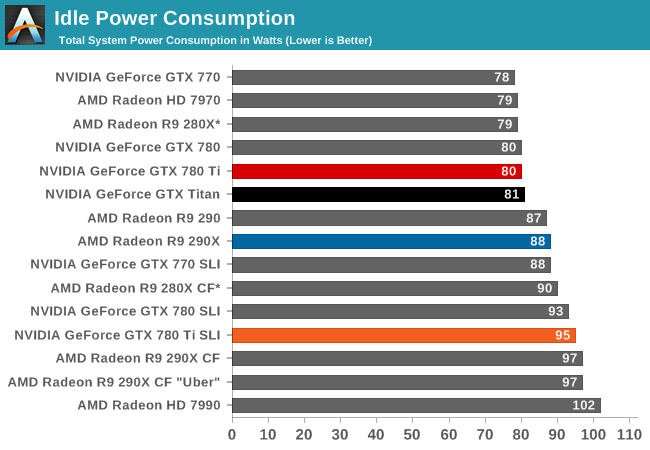
With all of our GK110 cards sharing a common design, at idle there’s very little to differentiate them. Other than GTX Titan’s extra 3GB of VRAM, we’re essentially looking at identical cards when idling.
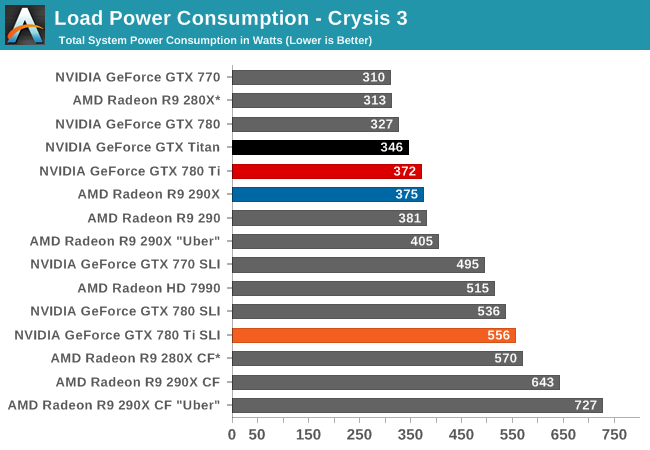
Moving on to load power, we can see the power/heat ramifications of the slight clockspeed increase coupled with the activation of the 15th SMX. Even with the further optimizations NVIDIA has put into the new revision of GK110, power consumption has gone up in accordance with the higher performance of the card, just as we’d expect. Since NVIDIA doesn’t notably alter their power efficiency here, that increased performance has to come at the cost of increased power consumption. Though in this benchmark it’s worth pointing out that we’re measuring from the wall and that GTX 780 Ti outperforms GTX Titan by 8%, so some of that 29W power difference will come from the higher CPU load caused by the increased framerates.
As for the GTX 780 Ti SLI, here we see power level off at 556W, 20W more than the GTX 780 SLI. Some (if not most) of that is going to be explained by the increased CPU power consumption from the GTX 780 Ti SLI’s higher framerates. Coupled with that is the fact that in SLI setups these cards get hotter, and hence have to downclock a bit more to maintain equilibrium, which helps to offset the increased power requirements of GTX 780 Ti and keep the SLI results so close to the GTX 780 SLI results.
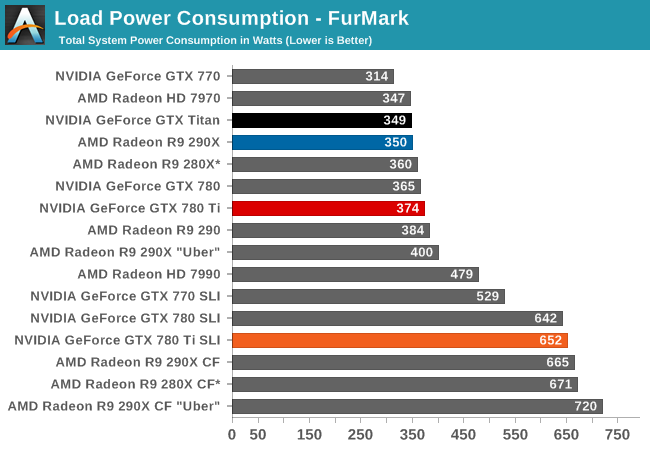
Switching over to FurMark, we find that power consumption is also up, but only slightly. With GPU Boost 2.0 clamping down on power consumption all of our GK110 cards should be clamped at 250W here, and with a difference between GTX 780 and GTX 780 Ti of under 10W, that’s exactly what appears to be happening here.
On a side note, it’s interesting to note here that under FurMark we’re seeing the GTX 780 Ti draw more power than the Radeon R9 290X. Despite the fact that the 290X has a higher rated TDP, in the card’s default quiet mode the card can’t actually dissipate as much heat (and thereby consume as much power) as the GTX 780 Ti can.
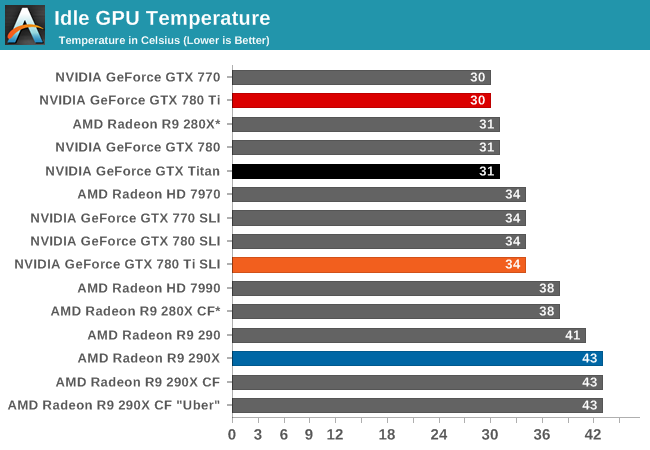
For idle temperatures we’re once again looking at cards that are for all intents and purposes identical. At 30C the GTX 780 Ti easily stays nice and cool.
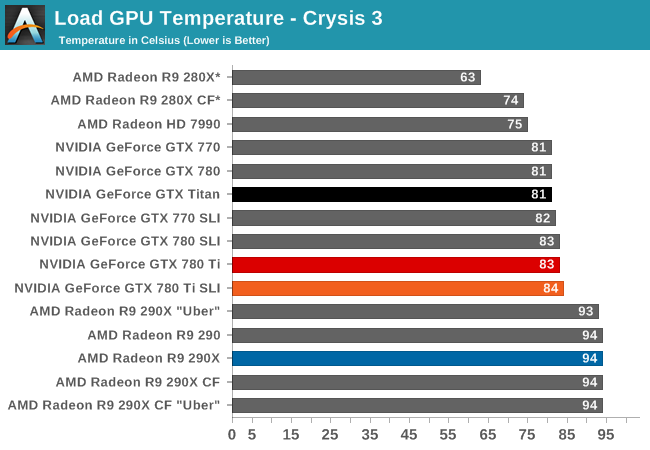
As we mentioned in our look at the GTX 780 Ti hardware, NVIDIA has increased their default temperature throttle point from 80C on the GTX Titan/780 to 83C on the GTX 780 Ti. The end result is that in all of our temperature limited tests the GTX 780 Ti will peak at 83C-84C, whereas the older GK110 cards will peak at 80C-81C.

FurMark reiterates what we saw with Crysis 3. The temps are up a bit across the board, while the GK110 cards are holding near their throttle points. The SLI setups meanwhile approach the upper-80s at 88C, reflecting the fact that even with blowers, there’s some impact on neighboring cards in high load situations.
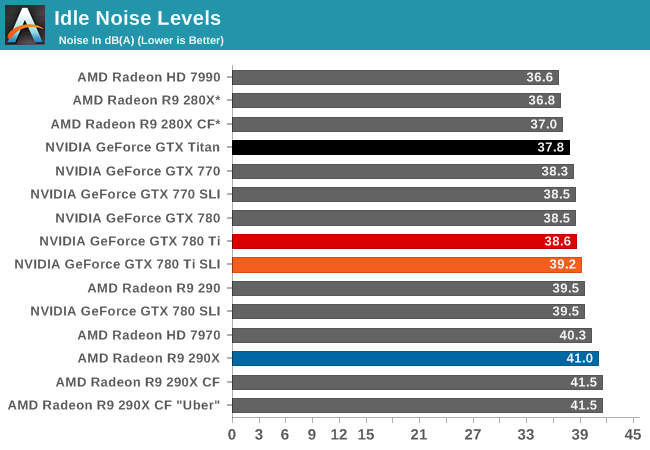
Our last idle scenario, we once again see all of our GK110 cards performing similarly, with idle noise levels in the 38dB-39dB range.
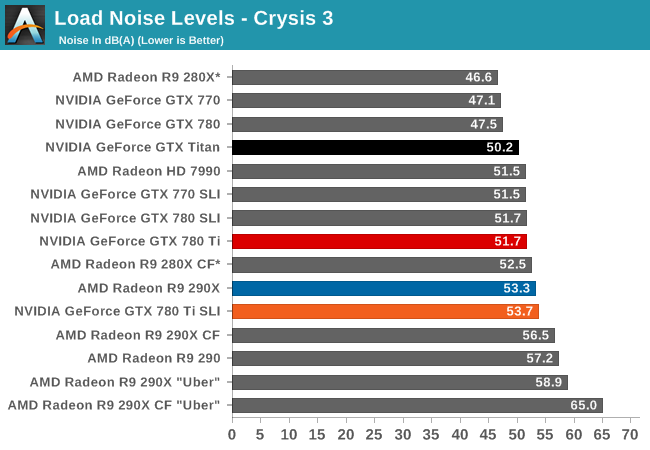
Moving on to our gaming load noise results, we can see the full repercussions of the GTX 780 Ti’s higher average power consumption coupled with the card’s higher temperature throttle point. Moving the throttle point along the same curve has the end result of moving higher the equilibrium point and thereby the card’s operating noise levels. As the fastest single-GPU card on this card, the GTX 780 Ti is still doing very well for itself and for a blower based design at 51.7dB, though at 1.5dB louder than GTX Titan and 4.2dB louder than GTX 780 the noise tradeoff for the card’s higher performance is very clear. Meanwhile the fact that it’s tied with the GTX 780 SLI comes with its own bit of irony.
Speaking of the GTX 780 SLI, we can see the noise impact of SLI configurations too. The GTX 780 Ti SLI levels out at 53.7dB, 2dB louder than our single-card configuration and 2dB louder than the GTX 780 SLI. At this point it’s just a bit louder than the 290X and quieter than a number of other 290 series setups.
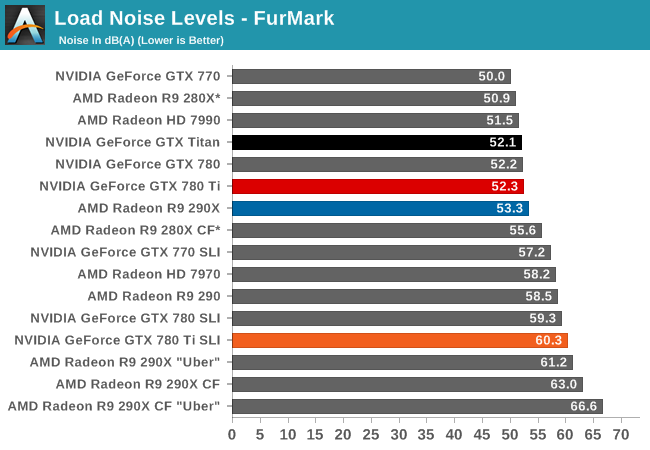
Finally with load noise levels under FurMark we can see where our various cards will peak at for noise levels. The GTX 780 Ti creeps up to 52.3dB, essentially tying with the GTX 780 and GTX Titan. Otherwise it comes in just behind the 290X, and the start of the pack for our multi-GPU setups.
As for the GTX 780 Ti SLI, like our single-card comparison points its up slightly as compared to the GTX 780 SLI.
Overall, our look at power, temperatures, and noise has been a rather straightforward validation of our earlier suspicions. GTX 780 Ti’s higher performance leads to higher power consumption, and will all other factors being held equal – including the cooler – power, temps, and noise levels all rise a bit as compared to GTX Titan and GTX 780. There’s no such thing as a free lunch here, and while GPU Boost 2.0 will keep the maximum levels suitably in check, on average GTX 780 Ti is going to be a bit worse than the other GK110 cards due to those factors. Though even with the increased noise levels in particular, GTX 780 Ti is still able to outperform 290X on noise while also delivering better gaming performance, which makes this another tidy victory for NVIDIA.










302 Comments
View All Comments
TheJian - Thursday, November 7, 2013 - link
Not sure you're correct. If NV set 780TI at 95 degrees default how fast would it be going out of the box? 1200mhz-1300mhz (that's 30% free!) judging by Ocing with stock fans already as I noted in the previous post with all the site links and it never goes above 83 doing it. They overclock them and don't hit uber noise. So you can get all the perf from overclocking and SMASH the 290/290x but still be more quiet. I don't call that keeping up. AMD put out a good card, but it has lots of issues (heat/noise and blown away by stock overclocks from NV that won't drive you crazy with noise).From the highest clock I saw so far (1304 at overclockers):
"On the GTX 780 Ti with the fan spinning at 100% locked in a chassis its not bad and will not wake your "neighbors" compared too the R9 290X."
So even at 100% nothing like 290x. :) I call that not competing too ;) How crappy is your fan/heatsink combo if you can't compare to a guy running 100%? Out of the box buyers for ref will be much happier with NV, not to mention all the features they have over AMD and 3 AAA games etc. You release a new card, while your competition just turns on some stuff they've disabled for a year waiting for you to catch them...LOL. On top, your card has "Variance" issues you are admitting you need to fix. You're running so close to crapout, they have been clocked at 669 in QUIET. That's UGLY right? Overclockers got 669 dips on quiet. How usable is that?
Da W - Thursday, November 7, 2013 - link
You done masturbating yet?DMCalloway - Thursday, November 7, 2013 - link
I think you under estimate just how 'happy' early gtx 780 adopters are with current pricing. For what they paid at launch they should've received a fully enabled chip. 7970ghz to r290x is a larger jump forward than gtx 780 to gtx 780Ti. We all remember what happened when AMD pushed their 7970 to the ghz. version in relation to the gtx 680. It's all relative except IMO Nvidia profits more for brand loyalty.Galidou - Thursday, November 7, 2013 - link
If nvidia would have enabled a full chip at 780 launch, imagine titan early adopter... We would have heard their anger far away in space...Margalus - Friday, November 8, 2013 - link
people got exactly what they paid for when they bought it. There is no reason to be upset because a better card is no available.Nevk - Thursday, November 7, 2013 - link
Nvidia fanboyz erererergrayson360 - Thursday, November 7, 2013 - link
Its so sad. I have a 780 and I basically only buy nvidia but that doesn't mean hate the competition. Any competition is good competition :DOverclockedCeleron - Thursday, November 7, 2013 - link
Trolls be damned. 290X = Bulldozer? Really? I am growing sick of these PR reps who troll tech sites. And for the record, a properly-cooled "GHz" edition of the R290X will probably beat GTX 780 Ti in many scenarios and still be over $100 cheaper. Enjoy paying more for less :-).1Angelreloaded - Thursday, November 7, 2013 - link
Probably not in this case, unless the 290x is fitted with a waterblock I don't see it happening. The problem is we will probably see triple slot vapor coolers like HOF galaxy which basically lends to the fact that multi GPU is a non possibility depending on your motherboard. Another thing is I would not put a 290x stock in a 350D or any other itx/matx solution case, between the thermals and the noise of the stock unit. I'm kinda excited for what Hawaii is, but also disappointed that this should have come out during the release of Nvidias 600 series not the end of 700 series cycle.PsiAmp - Thursday, November 7, 2013 - link
tomshardware tested Accelero Xtreme III with R9 290 and it made it nearly silent and very cool. Aslo had better performance.